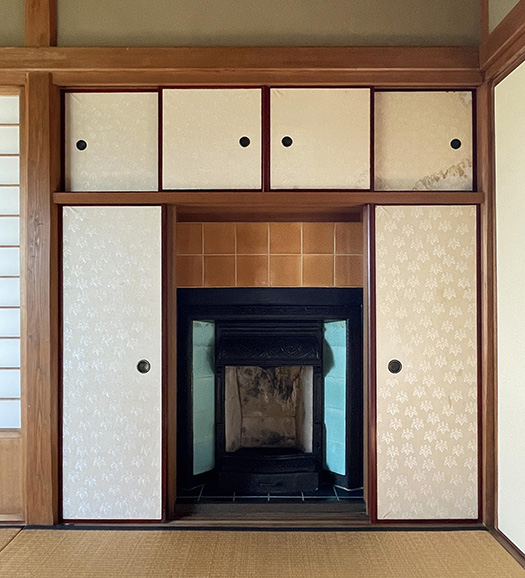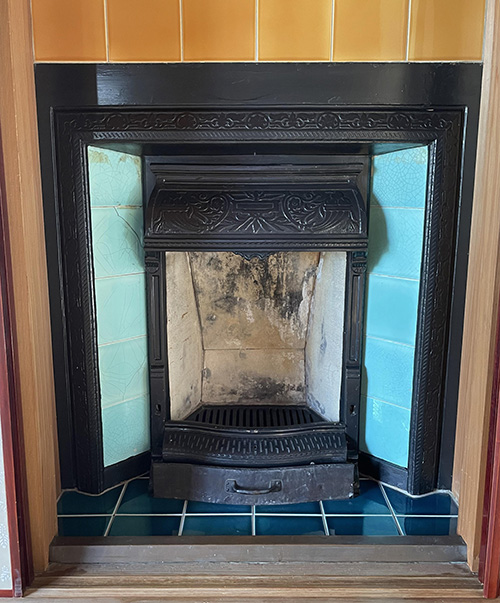

写真は愛知県犬山の「明治村」のなかの「西宮芝川邸」内部。
和のたたずまいの畳敷き込みの部屋のふすま戸を開けたところ。案内の方が開けたのですが、最初はなんのことやら気付かなかった。「これは襖に仕舞い込んだ暖炉です」と言われてオイオイ。
そもそも襖(ふすま)って、木などでできた骨組みの両面に紙や布を張ったものでそれに縁や引手を付けたもの。和室の仕切りに使う建具の一つである。単に「唐紙」と呼ばれることもある。
いかにも和風の「しつらい」を代表する建具の中から、いきなり洋風の、それも「暖房装置」が出現してくる。しげしげと見るとたしかに燃焼の痕跡が見られるので暖炉として使用もされたのでしょう。いまは犬山にあるけれど、移築前は西宮に建てられていた住宅。
温暖地域とはいえ、年に1−2ヶ月くらいは暖房が恋しくはなるだろう。
しかしほかの春夏秋には、ほぼ無用の長物。
囲炉裏までの本格的な定置型暖房は「むさくるしい」。だけれどもその一時期には満々とした火力の恩恵を得たい。だったら、使わないときには「襖の中に仕舞い込んで」、使うときだけ襖もはずして「火を眺めて暖を取る」という贅沢を楽しんだということかと。
しかしくるむ襖の素材は木と紙。火の扱いには相当の慎重さが求められただろう。暖炉本体は鋳物のように見えたので暖炉というよりも、まぁ一種の「ストーブ」暖房とも言える。
見ているうちにこれは,囲炉裏に対しての「火鉢」の発想が拡張したもののような気がしてきた。
この建物の設計者は武田吾一という建築家。1872-1938年。明治の文明の中核の「配電盤」(司馬遼太郎さんの命名)東京帝国大学工科大学造家学科出身で、卒業後同大の助教授となり、その後、海外渡航経験も豊富で、京都大学の創設委員となって京大の教授にもなった。昭和9年(1934年)には法隆寺国宝保存工事事務所長も務められている。
この襖仕舞い込み暖炉は、この建築家の創意に違いないだろう。欧米視察経験は豊富なので、このような洋風暖房装置を関西圏でどう「なじませるか」と思案したに違いない。
結果として、襖や鋳物などの表皮で、まるで火鉢の陶器での代わりをさせるみたいな発想を持ったのではないだろうか。
・・・オモシロいけれど、しかしその後の建築の歴史の中でこのような発意は発展していくことはなかった。「ちょっとムリがあったのでは?」という実感。
しかし北海道人としては、目が点になる発想力とは思わされた。
English version⬇
Fireplace” in sliding doors and fittings
A surprising warm-area idea. The idea of “covering” an open-type heating system. It may be an idea of a “brazier” for a sunken hearth. However, paper materials that are exposed to high temperatures are highly dangerous. However, paper material is very dangerous.
The photo shows the interior of the Nishinomiya Shibakawa Residence in the Meiji Village in Inuyama, Aichi Prefecture.
The fusuma door of the Japanese-style tatami-mat room has been opened. The tour guide opened the door, but I did not realize what it was at first. I was told, “This is a fireplace that has been hidden in a fusuma sliding door.
To begin with, a fusuma is a sliding door with a wooden frame covered on both sides with paper or cloth, to which a rim and pulls are attached. It is one of the fittings used to partition a Japanese-style room. It is sometimes simply called karakami.
Among the fittings that are representative of Japanese-style “shitsurai,” a Western-style “heating system” suddenly appears. Looking closely, one can see traces of combustion, so it must have been used as a fireplace. The house is now in Inuyama, but it was built in Nishinomiya before it was relocated.
Even though it is located in a temperate region, it is likely to miss the heat for 1-2 months a year.
However, in the spring, summer, and fall, it is almost useless.
Full-scale stationary heating up to the hearth is “too much work. However, I would like to benefit from a full fire at that time of the year. So, I thought that the owner enjoyed the luxury of “putting it away in the sliding doors” when not in use, and removing the sliding doors only when it was time to use it, and “watching the fire and getting warm.
However, the materials of the sliding doors are wood and paper. The fireplace itself looked like a cast iron fireplace. The fireplace itself looked like cast metal, so it could be called a kind of “stove” heating rather than a fireplace.
The more I looked at it, the more I felt that it was an extension of the idea of a “brazier” as opposed to a sunken hearth.
The architect of this building is Goichi Takeda (1872-1938). A “switchboard” (named by Ryotaro Shiba) at the core of Meiji civilization, he was a graduate of the Department of Architecture of the Tokyo Imperial University of Technology, and after graduation became an assistant professor of the same university, and later became a founding member of Kyoto University and a professor of Kyoto University, with extensive experience traveling abroad. In 1934, he also served as the director of the Horyuji National Treasure Conservation Construction Office.
This fireplace with sliding doors must have been an original idea of this architect. He must have had a lot of experience in visiting Europe and the United States, so he must have wondered how to make such a Western-style heating system “fit in” in the Kansai region.
As a result, they must have come up with the idea of using sliding doors, cast metal, and other materials to replace the ceramic surface of a hibachi brazier.
It is interesting, but such an idea did not develop in the history of architecture. I think it was a bit unreasonable. I feel that it was a bit unreasonable.
However, as a Hokkaido native, it is an eye-opening idea.
Posted on 4月 17th, 2024 by 三木 奎吾
Filed under: 住宅取材&ウラ話







コメントを投稿
「※誹謗中傷や、悪意のある書き込み、営利目的などのコメントを防ぐために、投稿された全てのコメントは一時的に保留されますのでご了承ください。」
You must be logged in to post a comment.